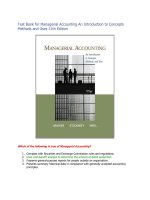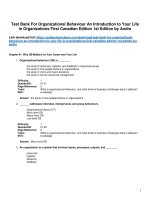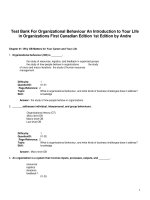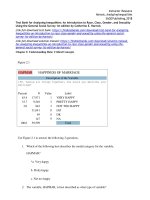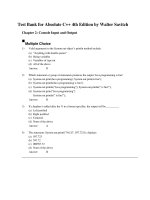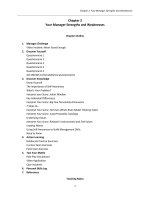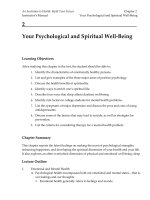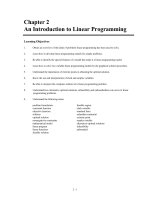Test bank and solution of an introduction to linear programming (1)
Bạn đang xem bản rút gọn của tài liệu. Xem và tải ngay bản đầy đủ của tài liệu tại đây (1.91 MB, 45 trang )
Chapter 2
An Introduction to Linear Programming
Learning Objectives
1.
Obtain an overview of the kinds of problems linear programming has been used to solve.
2.
Learn how to develop linear programming models for simple problems.
3.
Be able to identify the special features of a model that make it a linear programming model.
4.
Learn how to solve two variable linear programming models by the graphical solution procedure.
5.
Understand the importance of extreme points in obtaining the optimal solution.
6.
Know the use and interpretation of slack and surplus variables.
7.
Be able to interpret the computer solution of a linear programming problem.
8.
Understand how alternative optimal solutions, infeasibility and unboundedness can occur in linear
programming problems.
9.
Understand the following terms:
problem formulation
constraint function
objective function
solution
optimal solution
nonnegativity constraints
mathematical model
linear program
linear functions
feasible solution
feasible region
slack variable
standard form
redundant constraint
extreme point
surplus variable
alternative optimal solutions
infeasibility
unbounded
2-1
Chapter 2
Solutions:
1.
a, b, and e, are acceptable linear programming relationships.
c is not acceptable because of 2B 2
d is not acceptable because of 3 A
f is not acceptable because of 1AB
c, d, and f could not be found in a linear programming model because they have the above nonlinear
terms.
2.
a.
B
8
4
0
4
8
4
8
A
b.
B
8
4
0
A
c.
B
Points on line
are only feasible
points
8
4
0
4
2-2
8
A
An Introduction to Linear Programming
3.
a.
B
(0,9)
A
0
(6,0)
b.
B
(0,60)
A
0
(40,0)
c.
B
Points
on line are only
feasible solutions
(0,20)
A
(40,0)
0
4.
a.
B
(20,0)
(0,-15)
2-3
A
Chapter 2
b.
B
(0,12)
(-10,0)
A
c.
B
(10,25)
Note: Point shown was
used to locate position of
the constraint line
A
0
5.
B
a
300
c
200
100
b
A
0
100
200
2-4
300
An Introduction to Linear Programming
6.
7A + 10B = 420 is labeled (a)
6A + 4B = 420 is labeled (b)
-4A + 7B = 420 is labeled (c)
B
100
80
60
(b)
(c)
40
20
(a)
A
-100
-80
-60
-40
-20
0
20
40
60
80
100
7.
B
100
50
A
0
50
100
150
2-5
200
250
Chapter 2
8.
B
200
133 1/3
(100,200)
A
-200
0
-100
100
200
9.
B
(150,225)
200
100
0
(150,100)
100
-100
-200
2-6
200
300
A
An Introduction to Linear Programming
10.
B
5
4
Optimal Solution
A = 12/7, B = 15/7
3
Value of Objective Function = 2(12/7) + 3(15/7) = 69/7
2
1
A
0
1
2
(1) × 5
(2) - (3)
4
3
A
5A
5A
+
+
+
-
2B
3B
10B
7B
B
From (1), A = 6 - 2(15/7) = 6 - 30/7 = 12/7
2-7
5
=
6
=
15
=
30
= -15
= 15/7
6
(1)
(2)
(3)
Chapter 2
11.
B
A = 100
Optimal Solution
A = 100, B = 50
Value of Objective Function = 750
100
B = 80
A
0
100
200
12. a.
B
6
5
4
Optimal Solution
A = 3, B = 1.5
Value of Objective Function = 13.5
3
(3,1.5)
2
1
A
(0,0)
1
2
3
2-8
4
(4,0)
5
6
An Introduction to Linear Programming
b.
B
3
Optimal Solution
A = 0, B = 3
Value of Objective Function = 18
2
1
A
(0,0)
1
c.
2
3
4
5
6
7
8
There are four extreme points: (0,0), (4,0), (3,1,5), and (0,3).
13. a.
B
8
6
Feasible Region
consists of this line
segment only
4
2
0
A
2
b.
4
The extreme points are (5, 1) and (2, 4).
2-9
6
8
9
10
Chapter 2
c.
B
8
6
Optimal Solution
A = 2, B = 4
4
2
0
A
2
14. a.
4
6
Let F = number of tons of fuel additive
S = number of tons of solvent base
Max
s.t.
40F
+
30S
2/5F
+
1/ S
2
1/ S
5
3/ F
5
F, S 0
+
3/ S
10
200
Material 1
5
Material 2
21
Material 3
2 - 10
8
An Introduction to Linear Programming
b.
S
F
c.
Material 2: 4 tons are used, 1 ton is unused.
d.
No redundant constraints.
15. a.
2 - 11
Chapter 2
b.
Similar to part (a): the same feasible region with a different objective function. The optimal solution
occurs at (708, 0) with a profit of z = 20(708) + 9(0) = 14,160.
c.
The sewing constraint is redundant. Such a change would not change the optimal solution to the
original problem.
16. a.
b.
A variety of objective functions with a slope greater than -4/10 (slope of I & P line) will make
extreme point (0, 540) the optimal solution. For example, one possibility is 3S + 9D.
Optimal Solution is S = 0 and D = 540.
c.
Department
Cutting and Dyeing
Sewing
Finishing
Inspection and Packaging
Hours Used
1(540) = 540
5
/6(540) = 450
2
/3(540) = 360
1
/4(540) = 135
Max. Available
630
600
708
135
17.
Max
s.t.
5A
+ 2B
+
0S1
1A
2A
6A
- 2B
+ 3B
- 1B
+
1S1
+ 0S2
0S3
+
+ 1S2
1S3
+
=
=
=
420
610
125
A, B, S1, S2, S3 0
18. a.
Max
s.t.
4A
+ 1B
+ 0S1
10A
3A
2A
+ 2B
+ 2B
+ 2B
+ 1S1
+ 0S2
+ 0S3
+ 1S2
+ 1S3
A, B, S1, S2, S3 0
2 - 12
= 30
= 12
= 10
Slack
90
150
348
0
An Introduction to Linear Programming
b.
B
14
12
10
8
6
Optimal Solution
A = 18/7, B = 15/7, Value = 87/7
4
2
0
A
2
c.
4
6
8
+ 0S2
+ 0S3
10
S1 = 0, S2 = 0, S3 = 4/7
19. a.
Max
s.t.
3A
+
4B
+ 0S1
-1A
1A
2A
+
+
+
2B
2B
1B
+ 1S1
+ 1S2
+ 1S3
A, B, S1, S2, S3 0
2 - 13
= 8
= 12
= 16
(1)
(2)
(3)
Chapter 2
b.
B
14
(3)
12
10
(1)
8
6
Optimal Solution
A = 20/3, B = 8/3
Value = 30 2/3
4
2
(2)
0
A
2
c.
4
6
8
10
12
S1 = 8 + A – 2B = 8 + 20/3 - 16/3 = 28/3
S2 = 12 - A – 2B = 12 - 20/3 - 16/3 = 0
S3 = 16 – 2A - B = 16 - 40/3 - 8/3 = 0
20. a.
Max
s.t.
3A
+ 2B
A
3A
A
A
+ B
+ 4B
- S1
+ S2
- S3
-
- S4
B
A, B, S1, S2, S3, S4 0
2 - 14
=
=
=
=
4
24
2
0
An Introduction to Linear Programming
b.
c.
S1 = (3.43 + 3.43) - 4 = 2.86
S2 = 24 - [3(3.43) + 4(3.43)] = 0
S3 = 3.43 - 2 = 1.43
S4 = 0 - (3.43 - 3.43) = 0
2 - 15
Chapter 2
21. a. and b.
B
90
80
70
Constraint 2
60
50
40
Optimal Solution
Constraint 1
Constraint 3
30
Feasible Region
20
10
2A + 3B = 60
A
0
10
c.
20
30
40
50
60
70
80
90
100
Optimal solution occurs at the intersection of constraints 1 and 2. For constraint 2,
B = 10 + A
Substituting for B in constraint 1 we obtain
5A + 5(10 + A)
5A + 50 + 5A
10A
A
= 400
= 400
= 350
= 35
B = 10 + A = 10 + 35 = 45
Optimal solution is A = 35, B = 45
d.
Because the optimal solution occurs at the intersection of constraints 1 and 2, these are binding
constraints.
2 - 16
An Introduction to Linear Programming
e.
Constraint 3 is the nonbinding constraint. At the optimal solution 1A + 3B = 1(35) + 3(45) = 170.
Because 170 exceeds the right-hand side value of 90 by 80 units, there is a surplus of 80 associated
with this constraint.
22. a.
C
3500
3000
2500
Inspection and
Packaging
2000
Cutting and
Dyeing
5
1500
Feasible Region
4
1000
Sewing
3
5A + 4C = 4000
500
0
2
1
500
1000
1500
2000
2500
Number of All-Pro Footballs
A
3000
b.
Extreme Point
1
2
3
4
5
Coordinates
(0, 0)
(1700, 0)
(1400, 600)
(800, 1200)
(0, 1680)
Profit
5(0) + 4(0) = 0
5(1700) + 4(0) = 8500
5(1400) + 4(600) = 9400
5(800) + 4(1200) = 8800
5(0) + 4(1680) = 6720
Extreme point 3 generates the highest profit.
c.
Optimal solution is A = 1400, C = 600
d.
The optimal solution occurs at the intersection of the cutting and dyeing constraint and the inspection
and packaging constraint. Therefore these two constraints are the binding constraints.
e.
New optimal solution is A = 800, C = 1200
Profit = 4(800) + 5(1200) = 9200
2 - 17
Chapter 2
23. a.
Let E = number of units of the EZ-Rider produced
L = number of units of the Lady-Sport produced
Max
s.t.
2400E
+
6E
+
2E
+
1800L
3L 2100
L 280
2.5L 1000
E, L 0
Engine time
Lady-Sport maximum
Assembly and testing
b.
L
700
Number of EZ-Rider Produced
600
Engine
Manufacturing Time
500
400
Frames for Lady-Sport
300
Optimal Solution E = 250, L = 200
Profit = $960,000
200
100
Assembly and Testing
0
E
100
300
200
400
500
Number of Lady-Sport Produced
c.
24. a.
The binding constraints are the manufacturing time and the assembly and testing time.
Let R = number of units of regular model.
C = number of units of catcher’s model.
Max
s.t.
5R
+
8C
1R
+
1/ R
2
1/ R
8
+
3/ C
2
1/ C
3
1/ C
4
+
900
Cutting and sewing
300
Finishing
100
Packing and Shipping
R, C 0
2 - 18
.
An Introduction to Linear Programming
b.
C
1000
F
Catcher's Model
800
600
C&
400
S
P&
Optimal Solution
(500,150)
S
200
R
0
200
400
600
800
1000
Regular Model
c.
5(500) + 8(150) = $3,700
d.
C&S
1(500) + 3/2(150) = 725
F
1/ (500)
2
+ 1/3(150) = 300
P&S
1/ (500)
8
+ 1/4(150) = 100
e.
Department
C&S
F
P&S
25. a.
Usage
725
300
100
Slack
175 hours
0 hours
0 hours
Let B = percentage of funds invested in the bond fund
S = percentage of funds invested in the stock fund
Max
s.t.
b.
Capacity
900
300
100
0.06 B
+
0.10 S
B
0.06 B
B
+
+
0.10 S
S
=
0.3
0.075
1
Optimal solution: B = 0.3, S = 0.7
Value of optimal solution is 0.088 or 8.8%
2 - 19
Bond fund minimum
Minimum return
Percentage requirement
Chapter 2
26. a.
a.
Let N = amount spent on newspaper advertising
R = amount spent on radio advertising
Max
s.t.
50N
+ 80R
N
N
+
N
R = 1000 Budget
250 Newspaper min.
R 250 Radio min.
-2R
0 News 2 Radio
N, R 0
b.
R
1000
Radio Min
Optimal Solution
N = 666.67, R = 333.33
Value = 60,000
Budget
N = 2R
500
Newspaper Min
Feasible region
is this line segment
N
0
27.
5 00
1000
Let I = Internet fund investment in thousands
B = Blue Chip fund investment in thousands
Max
s.t.
0.12I
+
0.09B
1I
1I
6I
+
1B
+
4B
I, B 0
50
35
240
Available investment funds
Maximum investment in the internet fund
Maximum risk for a moderate investor
2 - 20
An Introduction to Linear Programming
B
Blue Chip Fund (000s)
60
Risk Constraint
Optimal Solution
I = 20, B = 30
$5,100
50
40
Maximum
Internet Funds
30
20
10
Objective
Function
0.12I + 0.09B
Available Funds
$50,000
0
I
10
30
20
40
50
60
Internet Fund (000s)
Internet fund
Blue Chip fund
Annual return
b.
$20,000
$30,000
$ 5,100
The third constraint for the aggressive investor becomes
6I + 4B 320
This constraint is redundant; the available funds and the maximum Internet fund investment
constraints define the feasible region. The optimal solution is:
Internet fund
Blue Chip fund
Annual return
$35,000
$15,000
$ 5,550
The aggressive investor places as much funds as possible in the high return but high risk Internet
fund.
c.
The third constraint for the conservative investor becomes
6I + 4B 160
This constraint becomes a binding constraint. The optimal solution is
Internet fund
Blue Chip fund
Annual return
$0
$40,000
$ 3,600
2 - 21
Chapter 2
The slack for constraint 1 is $10,000. This indicates that investing all $50,000 in the Blue Chip fund
is still too risky for the conservative investor. $40,000 can be invested in the Blue Chip fund. The
remaining $10,000 could be invested in low-risk bonds or certificates of deposit.
28. a.
Let W = number of jars of Western Foods Salsa produced
M = number of jars of Mexico City Salsa produced
Max
s.t.
1W
+
1.25M
5W
3W
+
2W
+
W, M 0
7M
1M
2M
4480
2080
1600
Whole tomatoes
Tomato sauce
Tomato paste
Note: units for constraints are ounces
b.
Optimal solution: W = 560, M = 240
Value of optimal solution is 860
29. a.
Let B = proportion of Buffalo's time used to produce component 1
D = proportion of Dayton's time used to produce component 1
Buffalo
Dayton
Maximum Daily Production
Component 1
Component 2
2000
1000
600
1400
Number of units of component 1 produced: 2000B + 600D
Number of units of component 2 produced: 1000(1 - B) + 600(1 - D)
For assembly of the ignition systems, the number of units of component 1 produced must equal the
number of units of component 2 produced.
Therefore,
2000B + 600D = 1000(1 - B) + 1400(1 - D)
2000B + 600D = 1000 - 1000B + 1400 - 1400D
3000B + 2000D = 2400
Note: Because every ignition system uses 1 unit of component 1 and 1 unit of component 2, we can
maximize the number of electronic ignition systems produced by maximizing the number of units of
subassembly 1 produced.
Max 2000B + 600D
In addition, B 1 and D 1.
2 - 22
An Introduction to Linear Programming
The linear programming model is:
Max
s.t.
2000B
+ 600D
3000B
B
+ 2000D
= 2400
1
1
0
D
B, D
The graphical solution is shown below.
D
1.2
1.0
30
.8
00
B+
20
.6
00
D
=2
40
.4
0
Optimal
Solution
2000B + 600D = 300
.2
B
0
.2
.4
.6
.8
1.0
Optimal Solution: B = .8, D = 0
Optimal Production Plan
Buffalo - Component 1
Buffalo - Component 2
Dayton - Component 1
Dayton - Component 2
.8(2000) = 1600
.2(1000) = 200
0(600) = 0
1(1400) = 1400
Total units of electronic ignition system = 1600 per day.
2 - 23
1.2
Chapter 2
30. a.
Let
E = number of shares of Eastern Cable
C = number of shares of ComSwitch
Max
s.t.
15E
+ 18C
40E
40E
+ 25C
25C
25C
E, C 0
50,000
15,000
10,000
25,000
Maximum Investment
Eastern Cable Minimum
ComSwitch Minimum
ComSwitch Maximum
b.
C
Number of Shares of ComSwitch
2000
Minimum Eastern Cable
1500
Maximum Comswitch
1000
Maximum Investment
500
Minimum Conswitch
0
500
1000
1500
Number of Shares of Eastern Cable
E
c.
There are four extreme points: (375,400); (1000,400);(625,1000); (375,1000)
d.
Optimal solution is E = 625, C = 1000
Total return = $27,375
2 - 24
An Introduction to Linear Programming
31.
B
6
Feasible
Region
4
2
A
0
2
4
6
3A + 4B = 13
Optimal Solution
A = 3, B = 1
Objective Function Value = 13
32.
A
B
A
B
A
2 - 25

